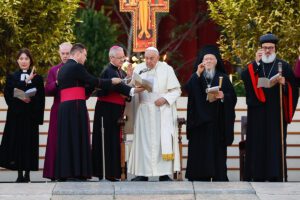VATICAN CITY (CNS) – A major leap forward in Christian unity began with an embrace, as Pope Francis recalled.
St. Paul VI and Orthodox Ecumenical Patriarch Athenagoras I of Constantinople met, and embraced, in Jerusalem in January 1964 and the following year they lifted the mutual excommunications their churches had issued in 1054.
Pope Francis marked the anniversary during his Angelus address Jan. 6, telling a crowd in St. Peter’s Square that the two leaders had broken down “a wall of incommunicability that had kept Catholics and Orthodox apart for centuries. Let us learn from the embrace of those two great men of the church on the path to Christian unity: praying together, walking together, working together.”

The praying, walking and working will be highlighted Jan. 18-25 as Christians around the world celebrate the Week of Prayer for Christian Unity.
After the embrace, Pope Paul VI had told the patriarch: “What can and must now commence to develop is that fraternal charity, which is ingenious in finding new ways of showing itself, and which, taking its lessons from the past, is ready to pardon, more ready to believe good than evil, careful above all to conform itself to the Divine Master and to allow itself to be drawn to and transformed by him.”
The prayers and reflections for this year’s week of prayer — focused on the theme, “You shall love the Lord your God … and your neighbor as yourself” — were prepared by an ecumenical group of Christians in Burkina Faso, which has been “experiencing a serious security crisis” since 2016. Christians have been the target of jihadist terrorist attacks, and hundreds of churches have been forced to close.
Yet, the materials said, the situation has prompted Christian communities not only to pray for peace, but to work together to care for people displaced by the fighting and to promote Christian-Muslim dialogue.
In Rome Pope Francis will be joined by Anglican Archbishop Justin Welby of Canterbury Jan. 25 for vespers closing the week of prayer and to witness just how much fraternal charity exists among bishops of their churches.
Bishop Brian Farrell, secretary of the Dicastery for Promoting Christian Unity, told Catholic News Service Jan. 9 that the pope and archbishop will formally send forth 25 pairs of bishops — an Anglican and a Catholic from the same region — who have promised to pray and work together, usually on a joint charitable project.
Pope Francis and Archbishop Welby sent forth a similar group of 19 Anglican and 19 Catholic bishops during a prayer service in Rome in 2019. The twinning is a project of the International Anglican-Roman Catholic Commission for Unity and Mission, known as IARCCUM. The teams of bishops will have seminars in both Rome and Canterbury, England.
Some of the highlights in Vatican ecumenical relations over the past year included: Pope Francis’ ecumenical peace pilgrimage to South Sudan with Archbishop Welby and the Rev. Iain Greenshields, moderator of the Church of Scotland; the Vatican visit of Coptic Orthodox Pope Tawadros II of Alexandria, Egypt, and Pope Francis’ announcement that he added the 21 Coptic martyrs murdered by Islamic State terrorists in 2015 to the Roman Martyrology, the list of saints’ feast days; and the ecumenical prayer vigil that preceded the opening of the Synod of Bishops on synodality.
Bishop Farrell said it is difficult to know what else to add because “visits, mutual support, ecumenical dialogues — it’s all so normal now that we take it for granted.”
“The challenge we have is to not get used to the good relations that we have and forget that we are on a journey toward full unity,” he said. “This is the temptation of the ecumenical movement, to just kind of be happy with what we have achieved.”
“We still are not being faithful to Jesus’ prayer at the Last Supper that his disciples be one,” the bishop said.
The global ecumenical movement also is increasingly focused on 2025, which is the 1,700th anniversary of the Council of Nicaea, which gave birth to the Nicene Creed.
The anniversary, Bishop Farrell said, will be an opportunity for the Christian churches “to bring the fundamentals of the faith into the center of Christian life because we have a tendency, especially here in the West, to think of the church as what it does, but we forget the very foundation of what we’re doing is our faith in God, the father, son and Holy Spirit.”
Another Nicaea-related ecumenical hope is making less progress, Bishop Farrell said.
Different Christian communities celebrated Easter on different days until the Council of Nicaea in 325 decided that for the unity of the Christian community and its witness, Easter would be celebrated on the first Sunday after the first full moon after the spring equinox.
But the Julian calendar, which is what Christians used in the fourth century and many Orthodox churches still use, was out of sync with the actual solar year, so March 21 – generally assumed to be the date of the northern hemisphere’s spring equinox – gradually “drifted” away from the actual equinox.
In 1582, Pope Gregory XIII, relying on the work of astronomers, reformed the calendar, dropping 10 days and making the equinox fall on March 21 again.
While the World Council of Churches, the Vatican and a variety of Christian churches and ecumenical bodies have tried to get all Christians to agree on a common date for Easter, Bishop Farrell said that “not all the churches are willing to adapt or change.”
However, an occasional coincidence in the Julian and Gregorian calendars means that even if they do not have an agreement for the future, Christians will celebrate Easter on the same day in 2025.
